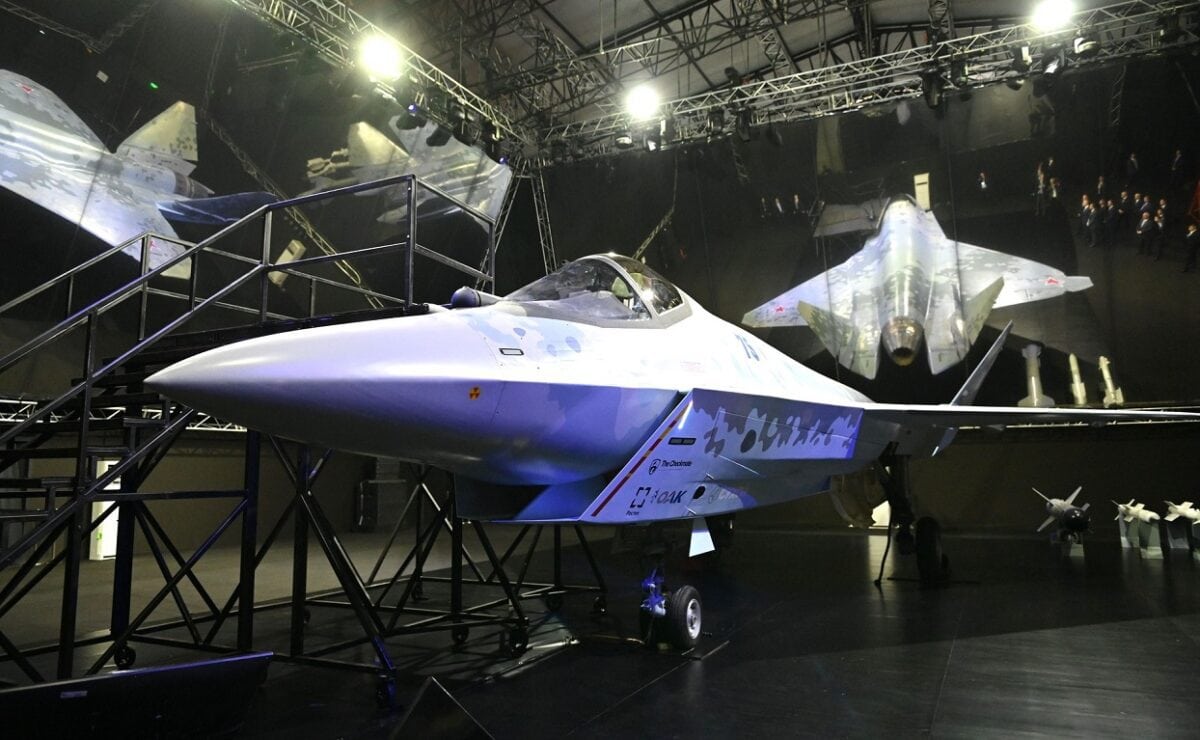Russia and stealth fighter are just a bunch of words that don’t go together well these days. Despite the fact that America has two stealth fighters already fielded, Moscow has had a lot of problems doing anything in this important area of aviation. And the Su-75 is just another example of this challenge:
– Despite Russia’s invasion of Ukraine proving to be highly damaging to the public image of Russian weaponry around the world, Moscow is pushing ahead with plans to promote some of its prestige projects abroad, notably including the Su-75.
What is the Su-75?
Marketed as the “Checkmate,” the Su-75 is designed to be an export version of the Su-57 multirole fighter. The Su-75 was first revealed at the 2021 MAKS Airshow near Moscow, was unveiled to possible international customers at the 2021 Dubai Airshow in the United Arab Emirates.
Given the early state of Su-75 in its development, most of what we know about the aircraft is based on publicly available characteristics shared by its Russian designers at the Sukhoi Design Bureau of the state-owned United Aircraft Corporation. Like its parent model, the Su-57, the Su-75 Checkmate is to be a fifth-generation aircraft. However, the propulsion of the Su-75 is configured differently from the Su-57, as it only appears to posses one engine, as opposed to the two which power the Su-57. The exact armament which the checkmate is intended to be equipped with is still unknown, but Russian sources report that it will be capable of carrying a combination of air-to-air missiles, air-to-ground missiles, unguided missiles, or laser-guided bombs, and is also intended to be outfitted with a cannon. According to Rostec, the Russian state defense industry consortium, the Checkmate is intended to be capable of carrying a payload of more than 7,000 kilograms with a baseline flight range of almost 3,000 kilometers.
Future of the Su-75
Speaking to the Russian state media outlet TASS on August 16, Yuri Slyusar, the head of the United Aircraft Corporation, said that Russia planned to build four prototype examples of the Su-75 by 2024, when the aircraft would begin flight tests. According to Slyusar, who made the announcement in question while at Russia’s Army-2022 defense industry expo, claimed that “preparations have been launched for the production of two prototypes.” This appears to conflict with prior Russian claims that “work” had begun on the first prototype examples of the Su-75 in November 2021, around the same time as the aircraft was rolled out in Dubai. However, by TASS’ own admission, the timeline of the aircraft’s first flight had previously been “altered,” naturally raising questions about how feasible the timeline announced by Slyusar in August really is.
How Has the Su-75 Been Marketed?
Being primarily intended for export markets, Russia has attempted to market the Su-75 as a more affordable and customizable alternative to Western fifth-generation aircraft such as the F-35. In the words of Sergei Chemezov, the head of Rostec, the unit cost of the Su-75 will reportedly be somewhere between $25 to $30 million, a fraction of the $77.9 million and $101.3 Lot 14 cost secured by the Pentagon for the F-35A and F-35B respectively. While a common marketing point of Russian weapons systems is often their advantage in price compared to Western analogues, the feasibility of the Su-75’s future development remains up in the air, as Russia has struggled with the development of its most cutting-edge fifth-generation technologies, as seen in the Su-57 project.

Su-57 and Su-75 Side-by-Side. Image Credit: Rostec.

Image: Creative Commons.

Image Credit: Chinese State Media.
Nonetheless, despite a generally lackluster showing (at best) of Russian military technology over the course of Russia’s invasion of Ukraine, Moscow doubled down on promises to sell some of its most advanced export-oriented systems to foreign customers at the Army-2022 expo, presumably including the Su-75. While the Su-75 or the somewhat more-established Su-57 have not seen action in Russia’s invasion (for fear of embarrassing losses in the case of the Su-57 and the fact that the aircraft has never flown for the Su-75), Russia will continue to try to press ahead with the development of prestige systems such as the Su-75 Checkmate to maintain the strength of its arms industry.
Wesley Culp is a Research Fellow at the Center for the Study of the Presidency and Congress. He regularly writes on Russian and Eurasian leadership and national security topics and has been published in The Hill and the Diplomatic Courier.

